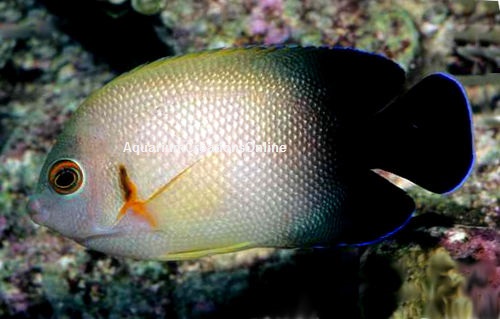Identification:
The Half Black Angelfish is one of the the least aggressive dwarf angelfish that will more than likely behave itself and be a good tank mate with others. It's interesting to note, the Half Black Angelfish is known for cross breeding in the wild with the Eibl's, Centropyge eibli and Lemonpeel Angelfish, Centropyge flavissima creating some interesting hybrid colorations. The Half Black Angelfish (Centropyge vroliki) is also known as the Pearl Scale Angelfish. Like its name implies, it is half black and half pearl in color. The front part of the body looks like a light creamy pearl color slowly fading into a dark black rear. The fins of this angel have fine light blue margins and the eyes are ringed in orange. Although not as brightly colored compared to some other angelfish, the Half Black's personality makes it a treasure to own The requirements are important for the fish's health. You must have a mature tank that is a minimum of 70 gallons with plenty of live rock and algae growth. The Half Black Angelfish starts out as a very shy fish that requires lots of hiding places in a rocky Aqua-scaped aquarium with lots of caves/crevices and ample amounts of live rock for grazing on microalgae and diatoms. Place the rock work with multiple places to hide so they will feel secure enough to come out often. This will provide security, and the more secure it feels, the more it will come out into the open. The Half-Black Angelfish is tolerant of other dwarf Angelfish and will share territory providing suitable space is provided (150 gallons or more).
The Half Black Angelfish require lots of hiding places in a rocky Aqua-scaped aquarium with lots of caves/crevices and ample amounts of live rock for grazing on microalgae and diatoms. While they should not harm non-sessile invertebrates such as shrimp, snails or crabs. They may occasionally nip at SPS corals and some species of polyp corals, zoanthids, and clam mantles. Although, if you start with a younger angel, say a small or medium, and they are well fed on a diet of Spirulina, marine algae, high-quality angelfish preparations, mysis or large chunks of raw meaty frozen shrimp, squid, clam, and mussels they tend not to bother corals too much.
All Half Black Angelfish are born female and can be paired according to size, not necessarily color. The larger fish becomes male, so making a pair is possible by buying a larger Half Black Angelfish and a smaller one, and within a few months hopefully they will assume their roles as male and female. Dwarf angelfish will spawn in captivity and some are now being raised, yet raising the larvae is quite a difficult task.
Food and Diet:
Dwarf Angelfish are omnivore's. In the wild it feeds primarily on algae, but it will also ingest tiny animals living in the algae. In captivity their diet will be mostly algae, but also offer some other proteins. Feeding them a variety of good foods is important. Offer various types of fresh and dried marine algae, spirulina enriched foods, mysis shrimp, shaved shrimp and other high-quality meaty foods, angelfish preparations, and flakes or pellets designed for algae eating fish. There are several good commercial foods available including Formula II and Angel Formula. Feed several times a day even if natural foods are present.
Recommended amount of drip acclimation time:
3+ hours
Approximate Purchase Size:
Small: 1" to 1-1/2"; Medium: 1-1/2" to 2-1/2"; Large: 2-1/2" to 3-1/2"
|



